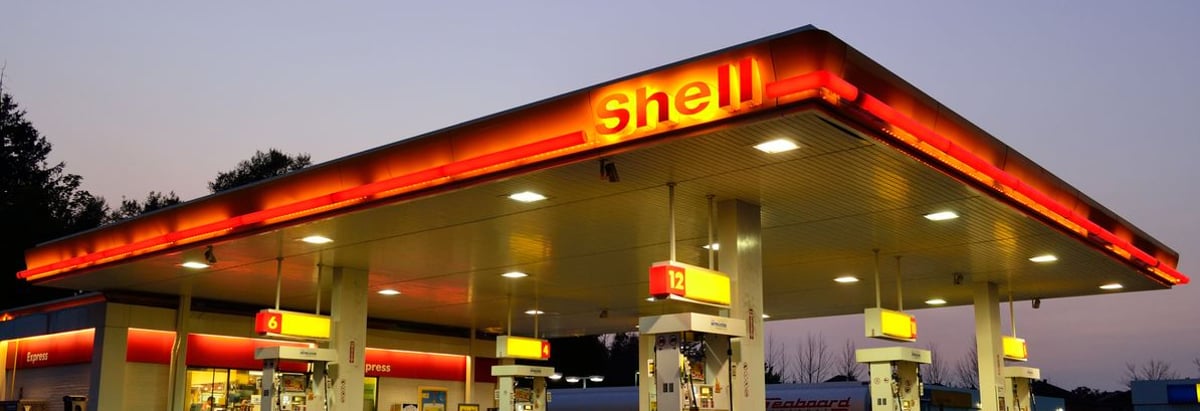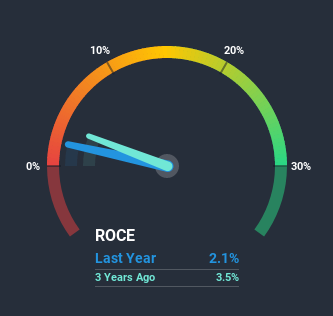
What are the early trends we should look for to identify a stock that could multiply in value over the long term? Ideally, a business will show two trends; firstly a growing return on capital employed (ROCE) and secondly, an increasing amount of capital employed. Put simply, these types of businesses are compounding machines, meaning they are continually reinvesting their earnings at ever-higher rates of return. Speaking of which, we noticed some great changes in Royal Dutch Shell's (AMS:RDSA) returns on capital, so let's have a look.
What is Return On Capital Employed (ROCE)?
For those that aren't sure what ROCE is, it measures the amount of pre-tax profits a company can generate from the capital employed in its business. To calculate this metric for Royal Dutch Shell, this is the formula:
Return on Capital Employed = Earnings Before Interest and Tax (EBIT) ÷ (Total Assets - Current Liabilities)
0.021 = US$6.3b ÷ (US$379b - US$71b) (Based on the trailing twelve months to September 2020).
Thus, Royal Dutch Shell has an ROCE of 2.1%. Ultimately, that's a low return and it under-performs the Oil and Gas industry average of 6.7%.
See our latest analysis for Royal Dutch Shell

Above you can see how the current ROCE for Royal Dutch Shell compares to its prior returns on capital, but there's only so much you can tell from the past. If you'd like, you can check out the forecasts from the analysts covering Royal Dutch Shell here for free.
What Can We Tell From Royal Dutch Shell's ROCE Trend?
While there are companies with higher returns on capital out there, we still find the trend at Royal Dutch Shell promising. More specifically, while the company has kept capital employed relatively flat over the last five years, the ROCE has climbed 103% in that same time. So it's likely that the business is now reaping the full benefits of its past investments, since the capital employed hasn't changed considerably. On that front, things are looking good so it's worth exploring what management has said about growth plans going forward.
What We Can Learn From Royal Dutch Shell's ROCE
In summary, we're delighted to see that Royal Dutch Shell has been able to increase efficiencies and earn higher rates of return on the same amount of capital. Since the total return from the stock has been almost flat over the last five years, there might be an opportunity here if the valuation looks good. That being the case, research into the company's current valuation metrics and future prospects seems fitting.
If you'd like to know more about Royal Dutch Shell, we've spotted 3 warning signs, and 1 of them is a bit concerning.
While Royal Dutch Shell isn't earning the highest return, check out this free list of companies that are earning high returns on equity with solid balance sheets.
When trading Royal Dutch Shell or any other investment, use the platform considered by many to be the Professional's Gateway to the Worlds Market, Interactive Brokers. You get the lowest-cost* trading on stocks, options, futures, forex, bonds and funds worldwide from a single integrated account. Promoted
New: Manage All Your Stock Portfolios in One Place
We've created the ultimate portfolio companion for stock investors, and it's free.
• Connect an unlimited number of Portfolios and see your total in one currency
• Be alerted to new Warning Signs or Risks via email or mobile
• Track the Fair Value of your stocks
This article by Simply Wall St is general in nature. It does not constitute a recommendation to buy or sell any stock, and does not take account of your objectives, or your financial situation. We aim to bring you long-term focused analysis driven by fundamental data. Note that our analysis may not factor in the latest price-sensitive company announcements or qualitative material. Simply Wall St has no position in any stocks mentioned.
*Interactive Brokers Rated Lowest Cost Broker by StockBrokers.com Annual Online Review 2020
Have feedback on this article? Concerned about the content? Get in touch with us directly. Alternatively, email editorial-team@simplywallst.com.
Market Insights
Community Narratives



